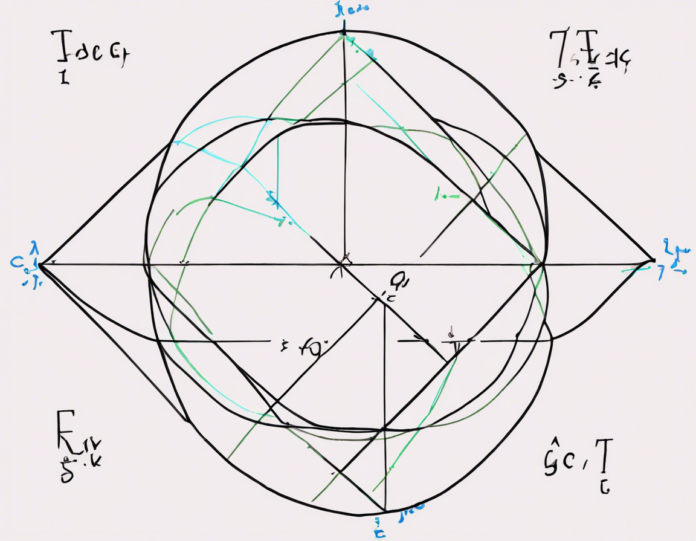When it comes to circumscribing quadrilaterals, a fascinating property that stands out is the relationship between the lengths of the sides that are opposite to each other. In this blog post, we will delve into the intricacies of these opposite sides of a circumscribing quadrilateral, exploring the theorems, proofs, and applications associated with this concept.
Understanding Circumscribing Quadrilaterals
Before we deep dive into the properties related to the opposite sides of a circumscribing quadrilateral, let’s ensure we are on the same page regarding what a circumscribing quadrilateral actually is.
A circumscribing quadrilateral is a quadrilateral that has a circumscribed circle around it, which means that all four vertices of the quadrilateral lie on the circumference of the circle. This circle is referred to as the circumscribed circle or circumcircle of the quadrilateral.
The Main Property: Opposite Sides are Supplementary
One of the key properties associated with the opposite sides of a circumscribing quadrilateral is that they are supplementary. In simpler terms, this means that the sum of the lengths of the two opposite sides of a circumscribing quadrilateral is always equal to 180 degrees.
Proof of the Property
To understand why the opposite sides of a circumscribing quadrilateral are supplementary, we need to turn to the realm of geometry and theorems.
The Inscribed Angle Theorem
The foundation for proving this property lies in the Inscribed Angle Theorem, which states that an angle inscribed in a circle is half the measure of the central angle that subtends the same arc. This theorem is crucial in establishing the relationship between the angles formed by the two opposite sides in a circumscribing quadrilateral.
Applying the Theorem
When we consider a circumscribing quadrilateral, each of the vertices of the quadrilateral lies on the circumference of the circle. This leads to the formation of a set of opposite angles within the quadrilateral.
By applying the Inscribed Angle Theorem, we can deduce that the sum of these opposite angles adds up to 180 degrees. This, in turn, translates to the sum of the lengths of the opposite sides being supplementary.
Implications and Applications
The property of opposite sides being supplementary in a circumscribing quadrilateral has several implications and applications in geometry and beyond.
Angle Calculations
This property can be utilized in angle calculations within a circumscribing quadrilateral, enabling the determination of missing angles based on the lengths of the sides.
Geometric Constructions
In geometric constructions involving circumscribing quadrilaterals, this property can aid in creating quadrilaterals with specific angle measures.
Problem Solving
When solving geometry problems or proofs related to circumscribing quadrilaterals, this property serves as a fundamental concept for establishing relationships between angles and sides.
Conclusion
In conclusion, the property of opposite sides of a circumscribing quadrilateral being supplementary is a fundamental and intriguing concept in geometry. By understanding the relationship between these sides and leveraging the Inscribed Angle Theorem, mathematicians can unlock a plethora of possibilities for geometric exploration and problem-solving.
Whether you’re a student delving into the realms of geometry or a math enthusiast seeking to broaden your knowledge, mastering the properties of circumscribing quadrilaterals, particularly the relationship between their opposite sides, is sure to deepen your understanding and appreciation of the beauty of mathematics.
Frequently Asked Questions (FAQs)
-
What is a circumscribing quadrilateral?
A circumscribing quadrilateral is a quadrilateral that has a circumscribed circle around it, with all four vertices lying on the circumference of the circle. -
Why are opposite sides of a circumscribing quadrilateral supplementary?
Opposite sides of a circumscribing quadrilateral are supplementary because of the angles formed at the vertices, which sum up to 180 degrees based on the Inscribed Angle Theorem. -
How is the Inscribed Angle Theorem applied in proving the property of opposite sides in a circumscribing quadrilateral?
The Inscribed Angle Theorem is used to establish the relationship between angles formed by opposite sides in a circumscribing quadrilateral, leading to the conclusion that the opposite sides are supplementary. -
What are some practical applications of the property of opposite sides being supplementary in circumscribing quadrilaterals?
This property is utilized in angle calculations, geometric constructions, and problem-solving scenarios within the realm of geometry. -
Can the property of opposite sides being supplementary be extended to other shapes besides quadrilaterals?
While the specific property applies to circumscribing quadrilaterals, similar concepts can be explored in other geometric shapes that have circumscribed circles.









